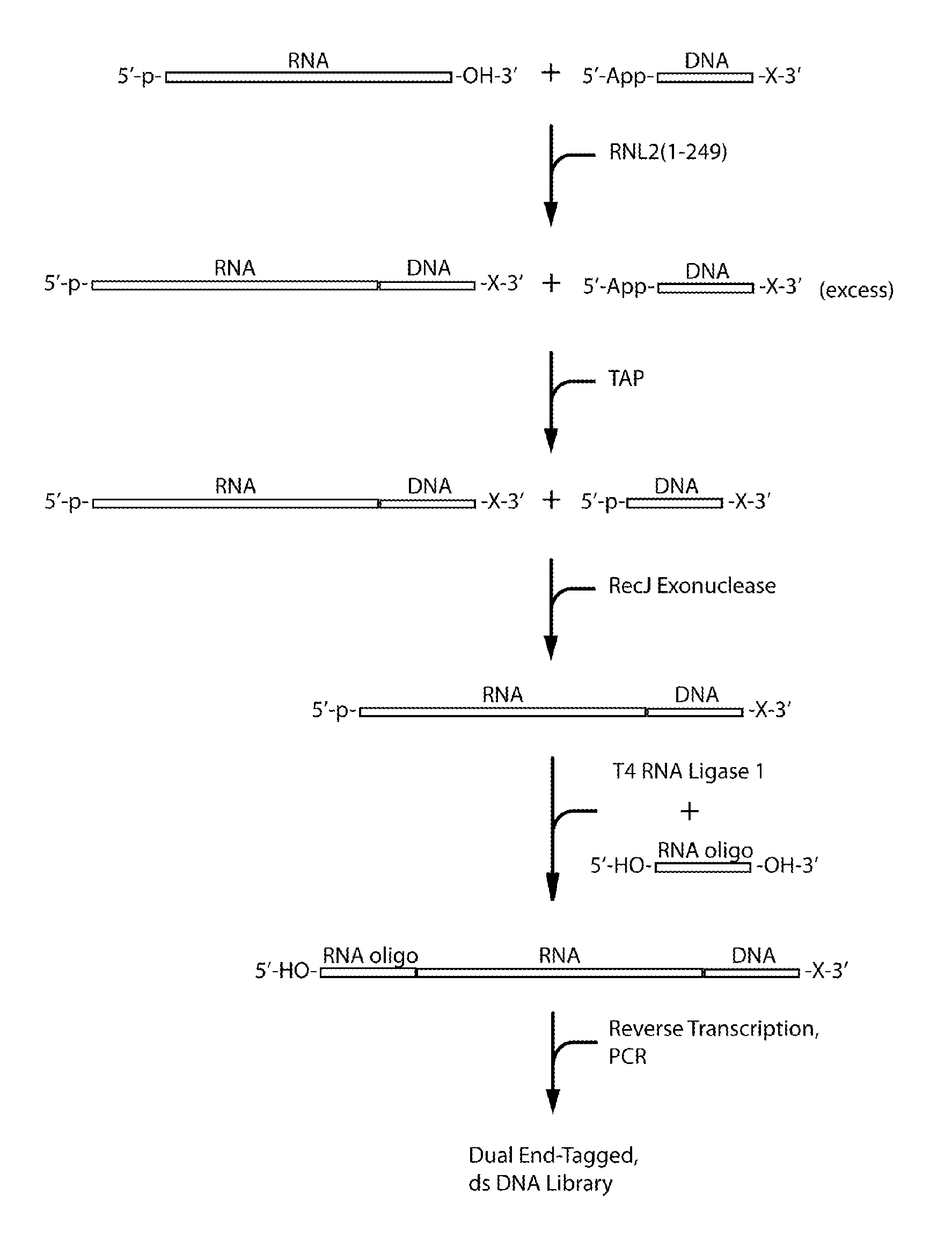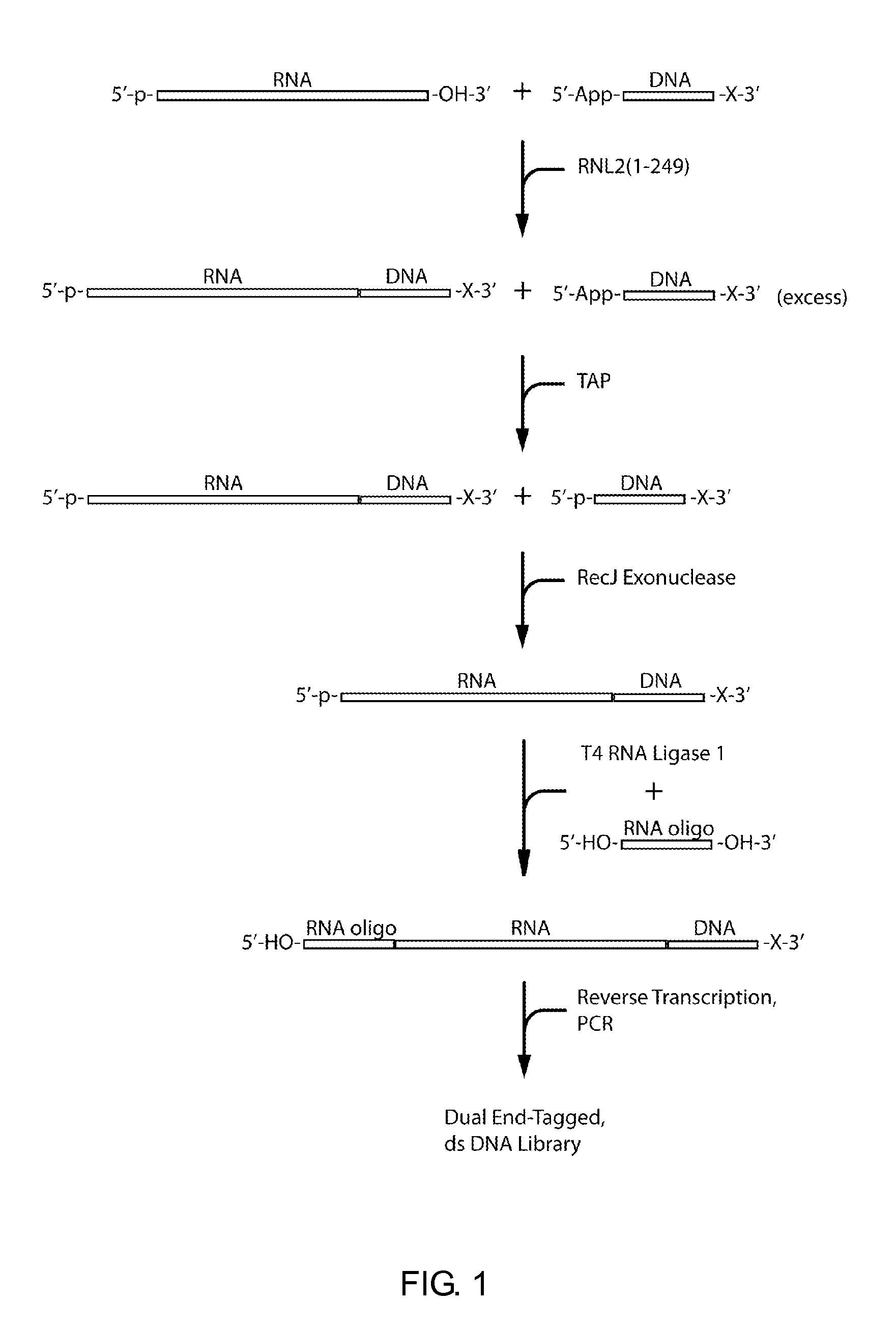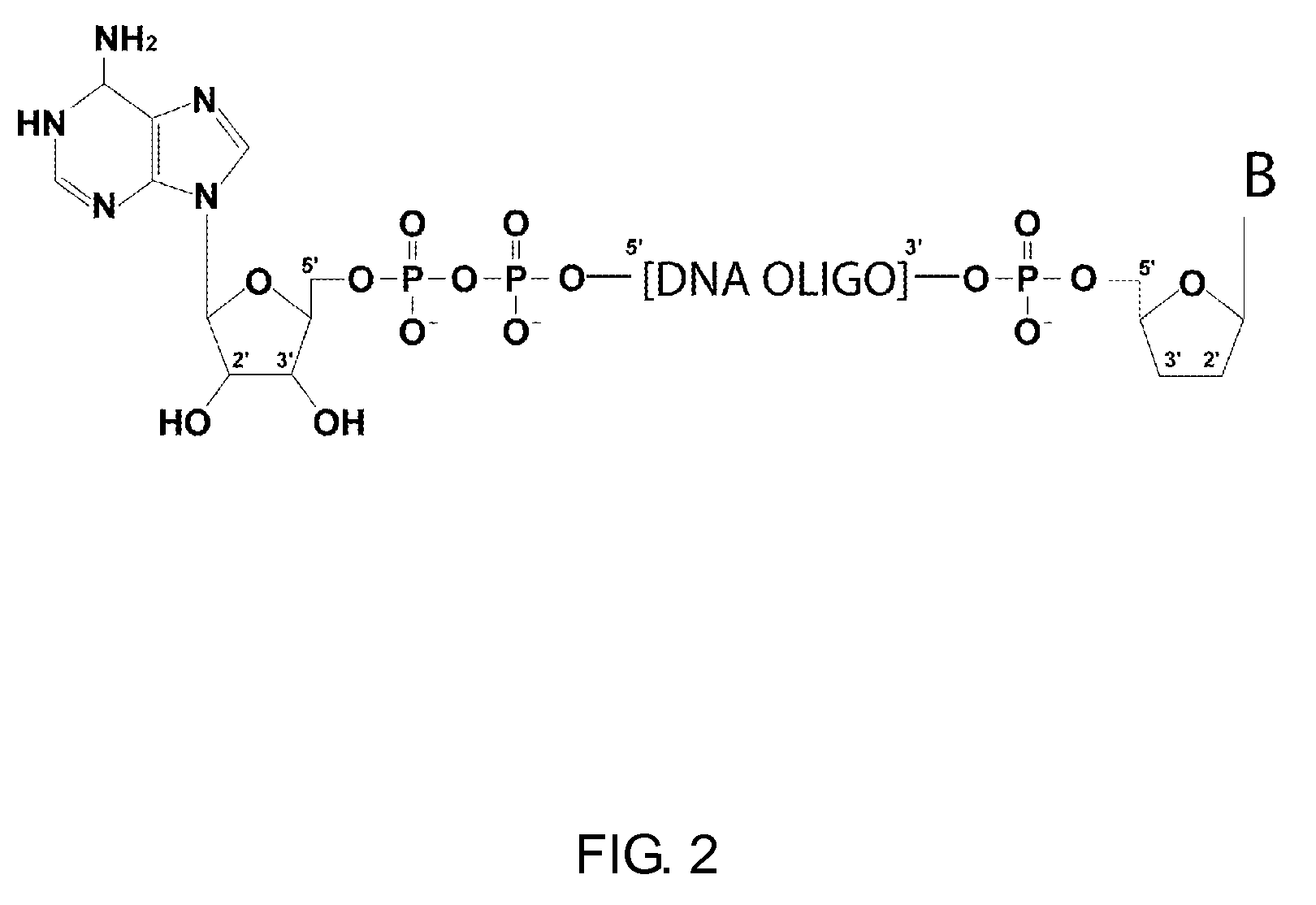Methods and kits for 3'-end-tagging of RNA
a ribonucleic acid and end-tagging technology, applied in the field of rna tagging, can solve the problems of difficult characterization of rna molecules using poly(dt)-containing tags, crude nuclear extracts used in vitro, and relatively low efficiency, so as to increase the sensitivity of detection of bimolecular ligation products, less input rna, and the effect of rapid and efficient enzymati
- Summary
- Abstract
- Description
- Claims
- Application Information
AI Technical Summary
Benefits of technology
Problems solved by technology
Method used
Image
Examples
example 1
A Single-Tube Reaction to Sequentially Block the 3′ End and Activate the 5′ End of a Single-Stranded Oligodeoxyribonucleotide
[0082]In this example, a synthetic DNA oligonucleotide (SEQ ID NO. 1) was purchased from Integrated DNA Technologies (Coralville, Iowa), with hydroxyl groups at both the 5′ and 3′ ends. This is a “standard” synthetic oligonucleotide, i.e., no chemical modifications were requested to be made to the 5′ and 3′ ends, or to the internal nucleotides.
SEQ ID NO. 1:5′-GAGCGGCCGCGAAGATCAGA-3′
[0083]The overall reaction involved three steps that were performed sequentially in the same reaction vessel.
[0084]Step 1: The first step was performed to block the 3′ end of the DNA oligonucleotide by reaction with TdT in the presence of ddATP. The following components were added in a 0.2-mL sterile microcentrifuge tube:
FinalComponentVolumeConcentrationNuclease-Free Water 8 μL—10X CircLigase Buffer 4 μL1XddATP (1 mM) 4 μL100 μMDNA oligonucleotide 20 μL5 μMSEQ ID NO. 1 (10 μM)TdT (3...
example 2
A Single-Tube Reaction to Activate the 5′ End of a Single-Stranded DNA Oligonucleotide that is Chemically Blocked at the 3′ End
[0091]Example 1 showed that a single-stranded DNA oligonucleotide can be 3′-end-blocked and 5′-end-activated enzymatically following the protocol disclosed. However, if the 3′ end of the DNA oligonucleotide is chemically blocked during oligonucleotide synthesis, the 5′ end can be activated by performing steps 2 and 3 in a single-tube reaction. This example illustrates the activation of the 5′ end of a synthetic, ss DNA oligonucleotide (SEQ ID NO. 2) containing a 3′-amino modifier (3′Am) as a blocking group. In this example, the 5′ end is phosphorylated and adenylated in a single-tube reaction that contains all the required components and enzymes.
SEQ ID NO. 2:5′-TCGTATGCCGTCTTCTGCTTG / 3Am / -3′
[0092]The following components were added in a 0.2-mL sterile microcentrifuge tube:
FinalComponentVolumeConcentrationNuclease-Free Water26.5 μL —10X CircLigase Buffer5 μL1...
example 3
Enzymatic Degradation of 5′-Adenylated, 3′-Blocked DNA Oligonucleotide
[0094]In this example, sequential enzymatic treatment with TAP and RecJ Exonuclease is used to degrade a 5′-adenylated, 3′-blocked DNA oligonucleotide (5′-App-DNA-X). Control reactions are also performed using a 5′-phosphorylated, 3′-blocked DNA oligonucleotide (5′-p-DNA-X). These modified oligonucleotides were prepared as described below from a DNA oligonucleotide purchased from TriLink Biotechnologies (San Diego, Calif.) with a 3′-terminal nucleotide that has a 2′-O-methyl group and a C3 spacer moiety (SEQ ID NO. 3).
SEQ ID NO. 3:5′-GACGAAGACAGTAGACANNNNNN-(2′O-Me)(N-propyl)-3′
[0095]5′-p-DNA-X was prepared following a procedure similar to that described in Example 1, Step 2, starting with 250 pmol of SEQ ID NO. 3. 5′-App-DNA-X was prepared following a procedure similar to that described in Example 1, Steps 2 and 3, starting with 250 pmol of SEQ ID NO. 3. After the reactions, the nucleic acid was purified by pheno...
PUM
| Property | Measurement | Unit |
|---|---|---|
| molar ratio | aaaaa | aaaaa |
| temperatures | aaaaa | aaaaa |
| time | aaaaa | aaaaa |
Abstract
Description
Claims
Application Information
 Login to View More
Login to View More - R&D
- Intellectual Property
- Life Sciences
- Materials
- Tech Scout
- Unparalleled Data Quality
- Higher Quality Content
- 60% Fewer Hallucinations
Browse by: Latest US Patents, China's latest patents, Technical Efficacy Thesaurus, Application Domain, Technology Topic, Popular Technical Reports.
© 2025 PatSnap. All rights reserved.Legal|Privacy policy|Modern Slavery Act Transparency Statement|Sitemap|About US| Contact US: help@patsnap.com



